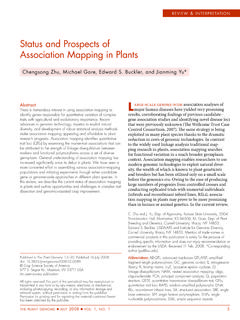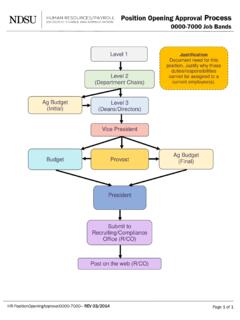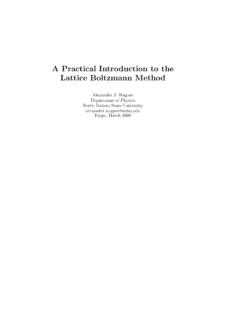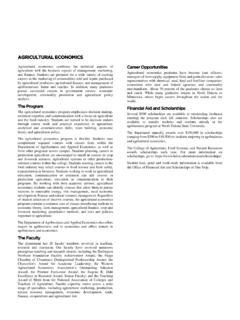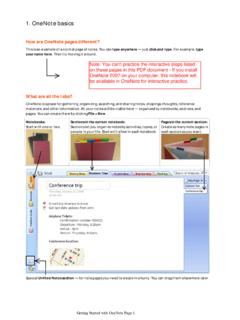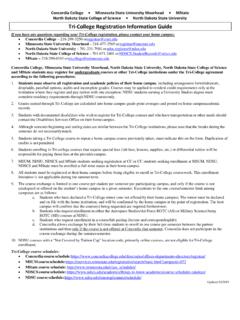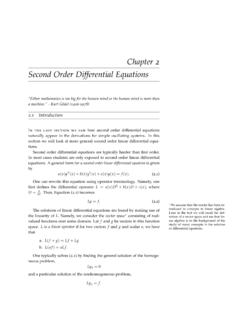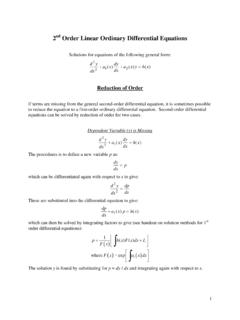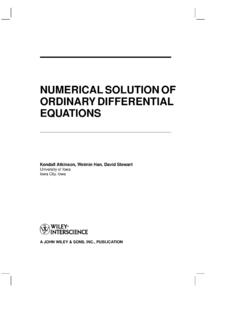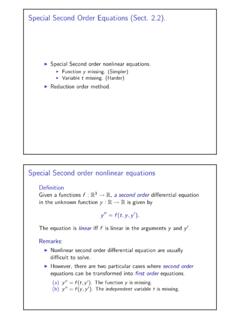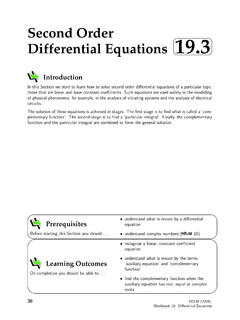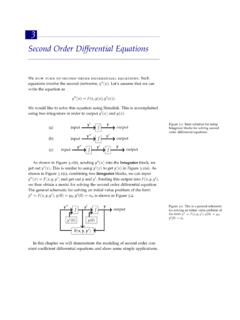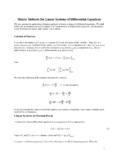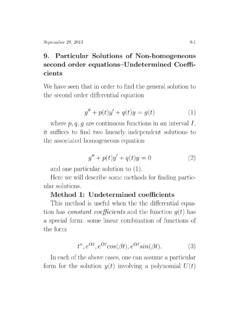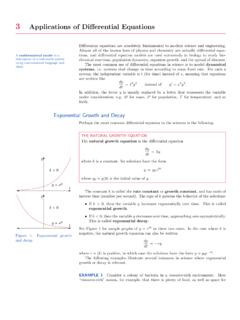Transcription of 16 Laplace transform. Solving linear ODE - NDSU
1 16 laplace transform . Solving linear ODEI this lecture I will explain how to use the Laplace transform to solve an ODE with constant main tool we will need is the following property from the last lecture:5 (t)g=F(s). ThenL{f (t)}=sF(s) f(0);L{f (t)}=s2F(s) sf(0) f (0):Now consider a second order IVPy +py +qy=f(t);y(0) =y0;y (0) =y1:(1)I consider a second order equation here, but it should be clear that similar considerations will lead toa solution of any order linear differential equation with constant the Laplace transform to the left and right hand sides of ODE (1):L{y +py +qy}=Lffg=)L{y }+pL{y }+qLfyg=Lffg=)s2 Lfyg sy(0) y (0) +psLfyg py(0) =Lffg=)(s2+ps+q)Lfyg sy0 y1 py0=Lffg=)(s2+ps+q)Y(s) sy0 y1 py0=F(s) =)Y(s) =F(s) +sy0+y1+py0s2+ps+q;where I used the notationY(s) =LfygandF(s) =Lffg.
2 The property of linearity was used,and also I used Property 5 to simplifyLfy gandLfy g. Since, due to Property 5 the Laplacetransform turns the operation of differentiation into the algebraic operation multiplication bys, then,instead of the initialdifferentialequation, I end up with a simplealgebraicequation forY(s). Thefinal step (and usually the most complex one) is to restorey(t) fromY(s), ,y(t) =L{1fYg:Note that to apply this approach, we need the initial conditions specified at the point zero. In general,if the initial conditions are not given, we can always put two parametersy(0) =y0andy (0) =y1such that the solution will be a two parameter using the Laplace transformy y=e3t;y(0) = 2:Application of the Laplace transform leads tosY(s) y(0) Y(s) =1s 3;MATH266: Intro to ODE by Artem Novozhilov, e-mail: Fall 20131therefore,Y(s) =2s 1+1(s 1)(s 3)=2s 1 12(1s 1 1s 3):Using the table to find the inverse Laplace transform , we obtainy(t) =L{1fYg= 2et 12(et e3t) =32et+12e3t:Example 3y + 2y=e3t;y(0) = 1.}}
3 Y (0) = 0:Applying the Laplace transform , I find(s2 3s+ 2)Y s+ 3 =1s 3=)Y(s) =s2 6s+ 10(s 3)(s 2)(s 1):To find the inverse Laplace transform we will need first simplify the expression forY(s) using thepartial fraction decomposition. Note thatY(s) is given by a rational function, , a polynomialdivided by polynomial, moreover, the highest degree of the numerator is strictly less than the highestdegree of the denominator. Hence, as we all learnt in Calculus,Y(s) =As 3+Bs 2+Cs 1:To findA,BandChere is especially simple. For example, forAmultiply both sides bys 3 andplugs= 3 into the expressions to obtainA=12.
4 In a similar wayB= 2 andC= , using the linearity of the inverse Laplace transform , we will findy(t) =L{1fYg=52et 2e2t+12e3t:Example 10y + 9y= 5t;y(0) = 1;y (0) = 2:Applying the Laplace transform to both side, we find(s2 10s+ 9)Y+s 2 10 =5s2=)Y(s) =5 + 12s2 s3s2(s 9)(s 1):To find the inverse Laplace transform we will need first simplify the expression forY(s) using thepartial fraction decomposition:5 + 12s2 s3s2(s 9)(s 1)=As+Bs2+Cs 9+Ds 1:We findB=59;D= 2;C=3181;A=5081:Therefore, using the linearity of the inverse Laplace transform ,y(t) =5081+5t9+3181e9t 2et:2 Example 6y + 15y= 2 sin 3t;y(0) = 1;y (0) = 4:We have(s2 6s+ 15)Y+s 2 =6s2+ 9=)Y(s) = s3+ 2s2 9s+ 24(s2+ 9)(s2 6s+ 15)=As+Bs2+ 9+Cs+Ds2 6s+ 15:To find the constants, we need to simplify the expression on the right (find the common denominator)and equate the coefficients at the equal powers:s3:A+C= 1s2: 6A+B+D= 2s1: 15A 6B+ 9C= 9s0: 15B+ 9D= 24 The solution isA=110;B=110;C= 1110;D=52:Hence, we gotY(s) =110(s+ 1s2+ 9+ 11s+ 25s2 6s+ 15):Now we need to find the inverse Laplace transform .}
5 Let us start with the first term:L{1{s+ 1s2+ 9}=L{1{ss2+ 9+1s2+ 9}=L{1{ss2+ 9}+13L{1{3s2+ 9}= cos 3t+13sin 3t:The second term is slightly more involved. Rearrange the expression in the following way (rememberthat we can always add and subtract the same expression and multiply and divide by the sameexpression different from zero): 11s+ 25s2 6s+ 15= 11s+ 25(s 3)2+ 6= 11(s 3) 8(s 3)2+ 6= 11(s 3)(s 3)2+ 6 8p6p6(s 3)2+ 6:NowL{1{ 11s+ 25s2 6s+ 15}= 11e3tcosp6t 8p6e3tsinp6t:The final answer hence isy(t) =L{1fYg=110(cos 3t+13sin 3t 11e3tcosp6t 8p6e3tsinp6t):3}}}}}}

